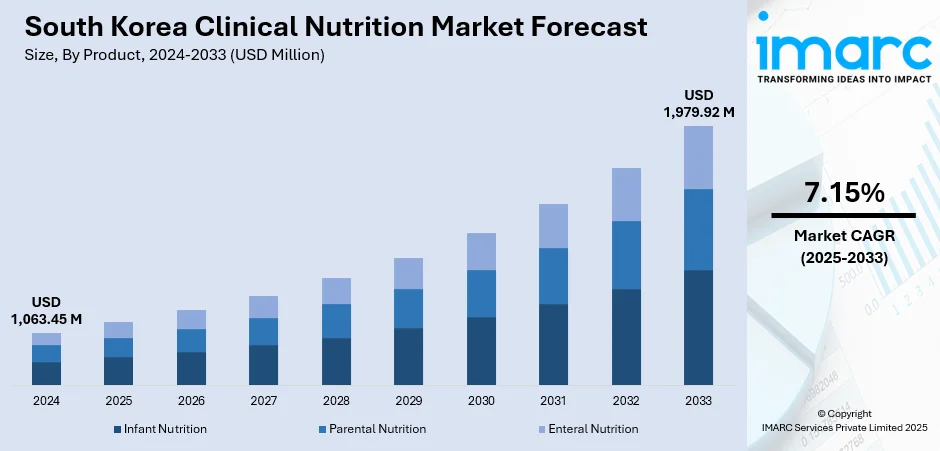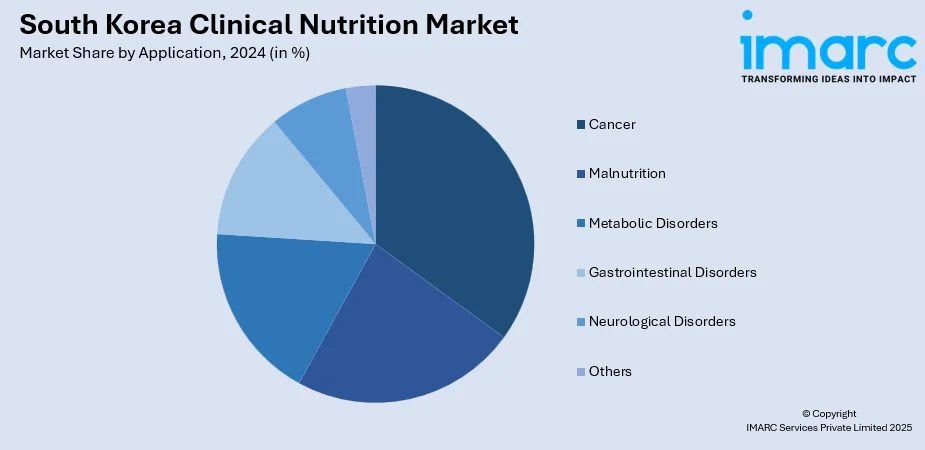
South Korea Clinical Nutrition Market Size, Share, Trends and Forecast by Product, Route of Administration, Application, End User, and Region, 2025-2033
South Korea Clinical Nutrition Market Overview:
The South Korea clinical nutrition market size reached USD 1,063.45 Million in 2024. Looking forward, the market is expected to reach USD 1,979.92 Million by 2033, exhibiting a growth rate (CAGR) of 7.15% during 2025-2033. The market is expanding rapidly, driven by heightened awareness about nutrition's role in managing lifestyle and chronic diseases, and aging demographics boosting demand for tailored enteral and parenteral therapies. Innovations in personalized formulations and stronger hospital-level adoption further enhance access to clinical nutritional support. These trends collectively strengthen the South Korea clinical nutrition market share.
|
Report Attribute
|
Key Statistics
|
|---|---|
|
Base Year
|
2024
|
|
Forecast Years
|
2025-2033
|
|
Historical Years
|
2019-2024
|
| Market Size in 2024 | USD 1,063.45 Million |
| Market Forecast in 2033 | USD 1,979.92 Million |
| Market Growth Rate 2025-2033 | 7.15% |
South Korea Clinical Nutrition Market Trends:
Aging Population & Rising Chronic Disease Prevalence
South Korea’s rapidly aging demographic, combined with the increasing incidence of chronic conditions such as obesity, diabetes, cardiovascular disorders, hypertension, and osteoporosis, is a key market driver. As more seniors and urban adults require nutrition therapy alongside clinical interventions, demand grows for enteral and parenteral formulas supporting long-term disease management, recovery protocols, and healthy aging. Preventive and therapeutic nutritional solutions are increasingly adopted within hospitals and care facilities to mitigate comorbidity risk and enhance patient outcomes. Government health campaigns and institutional nutrition strategies further reinforce recognition of clinical nutrition’s role in curbing escalating lifestyle-related disease burden, elevating its relevance in South Korea’s evolving healthcare ecosystem.

To get more information on this market, Request Sample
Awareness of Nutrition’s Role in Preventive Care & Functional Foods Adoption
The growing consumer consciousness around the health benefits of targeted nutrition, particularly in managing or preventing chronic conditions, has fueled the adoption of medical nutrition products, which is boosting the South Korea clinical nutrition market growth. Alongside this, South Korea’s functional food and health supplement culture aligns closely with preventive wellness goals. Clinical nutrition products that combine therapeutic benefits with palatability and convenience are increasingly accepted in hospital settings and outpatient care. Policies and public health initiatives that promote balanced diets and nutritional education also contribute to greater acceptance of clinical nutrition solutions. This trend enhances trust in enteral and parenteral formulations as viable adjuncts to medication, supporting their integration into both inpatient and domiciliary care settings.
Technological & Healthcare Infrastructure Advancements
South Korea's highly advanced healthcare system and robust infrastructure provide strong support for clinical nutrition adoption. Modern hospitals, widespread clinical nutrition protocols, and government-backed nutritional programs facilitate widespread implementation of enteral and parenteral therapies. Additionally, innovations in personalized nutrition—powered by technologies like AI, big data analytics, and genetic assessment—enable customized nutrition solutions tailored to specific patient conditions. These technological capabilities boost prescription precision and clinical acceptance. Within this regulated, technologically sophisticated environment, both domestic and global firms are increasingly launching clinical nutrition products and therapies, supported by streamlined approvals and collaborative research across academic–medical industry partnerships. This robust ecosystem reinforces market growth and product penetration.
South Korea Clinical Nutrition Market Segmentation:
IMARC Group provides an analysis of the key trends in each segment of the market, along with forecasts at the country and regional levels for 2025-2033. Our report has categorized the market based on product, route of administration, application, and end user.
Product Insights:
- Infant Nutrition
- Parental Nutrition
- Enteral Nutrition
The report has provided a detailed breakup and analysis of the market based on product. This includes infant nutrition, parental nutrition, and enteral nutrition.
Route of Administration Insights:
- Oral
- Enteral
- Parenteral
A detailed breakup and analysis of the market based on the route of administration have also been provided in the report. This includes oral, enteral, and parenteral.
Application Insights:

- Cancer
- Malnutrition
- Metabolic Disorders
- Gastrointestinal Disorders
- Neurological Disorders
- Others
A detailed breakup and analysis of the market based on the application have also been provided in the report. This includes cancer, malnutrition, metabolic disorders, gastrointestinal disorders, neurological disorders, and others.
End User Insights:
- Pediatric
- Adults
- Geriatric
A detailed breakup and analysis of the market based on the end user have also been provided in the report. This includes pediatric, adults, and geriatric.
Regional Insights:
- Seoul Capital Area
- Yeongnam (Southeastern Region)
- Honam (Southwestern Region)
- Hoseo (Central Region)
- Others
The report has also provided a comprehensive analysis of all the major regional markets, which include Seoul Capital Area, Yeongnam (Southeastern Region), Honam (Southwestern Region), Hoseo (Central Region), and others.
Competitive Landscape:
The market research report has also provided a comprehensive analysis of the competitive landscape. Competitive analysis such as market structure, key player positioning, top winning strategies, competitive dashboard, and company evaluation quadrant has been covered in the report. Also, detailed profiles of all major companies have been provided.
South Korea Clinical Nutrition Market News:
- In February 2025, the Ministry of Food and Drug Safety (KFDA) announced on the 18th the release of a "customized nutrition management guide" designed to support the dietary requirements of adults vulnerable to diabetes. This targeted dietary resource aims to help lower the prevalence of diabetes among at-risk individuals in South Korea.
South Korea Clinical Nutrition Market Report Coverage:
| Report Features | Details |
|---|---|
| Base Year of the Analysis | 2024 |
| Historical Period | 2019-2024 |
| Forecast Period | 2025-2033 |
| Units | Million USD |
| Scope of the Report | Exploration of Historical Trends and Market Outlook, Industry Catalysts and Challenges, Segment-Wise Historical and Future Market Assessment:
|
| Products Covered | Infant Nutrition, Parental Nutrition, Enteral Nutrition |
| Route of Administrations Covered | Oral, Enteral, Parenteral |
| Applications Covered | Cancer, Malnutrition, Metabolic Disorders, Gastrointestinal Disorders, Neurological Disorders, Others |
| End Users Covered | Pediatric, Adults, Geriatric |
| Regions Covered | Seoul Capital Area, Yeongnam (Southeastern Region), Honam (Southwestern Region), Hoseo (Central Region), Others |
| Customization Scope | 10% Free Customization |
| Post-Sale Analyst Support | 10-12 Weeks |
| Delivery Format | PDF and Excel through Email (We can also provide the editable version of the report in PPT/Word format on special request) |
Key Questions Answered in This Report:
- How has the South Korea clinical nutrition market performed so far and how will it perform in the coming years?
- What is the breakup of the South Korea clinical nutrition market on the basis of product?
- What is the breakup of the South Korea clinical nutrition market on the basis of route of administration?
- What is the breakup of the South Korea clinical nutrition market on the basis of application?
- What is the breakup of the South Korea clinical nutrition market on the basis of end user?
- What is the breakup of the South Korea clinical nutrition market on the basis of region?
- What are the various stages in the value chain of the South Korea clinical nutrition market?
- What are the key driving factors and challenges in the South Korea clinical nutrition market?
- What is the structure of the South Korea clinical nutrition market and who are the key players?
- What is the degree of competition in the South Korea clinical nutrition market?
Key Benefits for Stakeholders:
- IMARC’s industry report offers a comprehensive quantitative analysis of various market segments, historical and current market trends, market forecasts, and dynamics of the South Korea clinical nutrition market from 2019-2033.
- The research report provides the latest information on the market drivers, challenges, and opportunities in the South Korea clinical nutrition market.
- Porter's five forces analysis assist stakeholders in assessing the impact of new entrants, competitive rivalry, supplier power, buyer power, and the threat of substitution. It helps stakeholders to analyze the level of competition within the South Korea clinical nutrition industry and its attractiveness.
- Competitive landscape allows stakeholders to understand their competitive environment and provides an insight into the current positions of key players in the market.
Need more help?
- Speak to our experienced analysts for insights on the current market scenarios.
- Include additional segments and countries to customize the report as per your requirement.
- Gain an unparalleled competitive advantage in your domain by understanding how to utilize the report and positively impacting your operations and revenue.
- For further assistance, please connect with our analysts.
 Request Customization
Request Customization
 Speak to an Analyst
Speak to an Analyst
 Request Brochure
Request Brochure
 Inquire Before Buying
Inquire Before Buying




.webp)




.webp)












